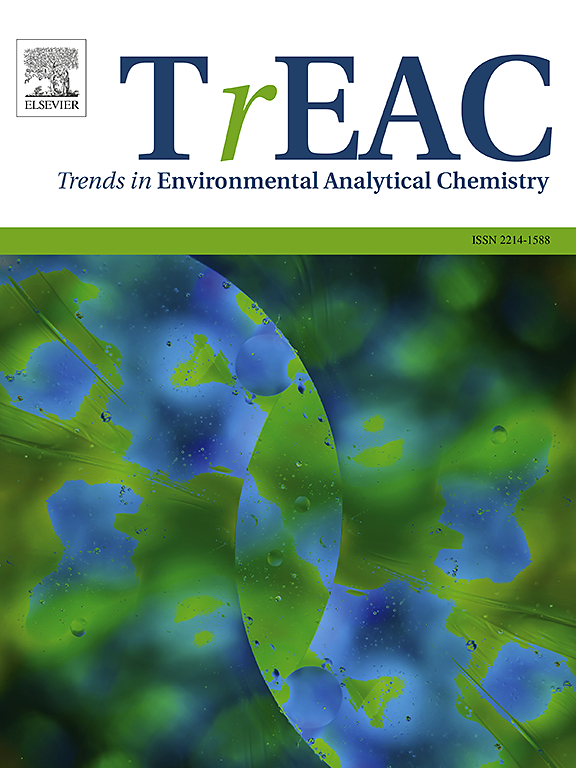用于环境中全氟辛烷磺酸高级评估的基于过硫酸盐的总可氧化前体(TOP)检测方法--综述
IF 11.1
2区 化学
Q1 CHEMISTRY, ANALYTICAL
引用次数: 0
摘要
数百万全氟和多氟烷基物质(PFASs)的结构非常复杂,这给其化学分析带来了巨大挑战。部分应对这一挑战的方法之一是所谓的总可氧化前体(TOP)测定法。然而,在过去的几年中,全球不同的实验室以多种方式对该方法进行了修改,从而导致了令人困惑的各种 TOP 分析方法。本综述旨在概述这种方法的复杂性,并确定关键参数及其对结果和方法解释的潜在影响。所有可用研究的参数都汇总在一个复杂的表格中。氧化试剂的用量和浓度、反应时间、氧化过程中的温度和 pH 值、内标添加时间以及所分析的氧化产物的种类被确定为影响氧化效率、反应产物性质和前体评估完整性的关键因素。目前 TOP 检测方法的复杂性表明需要进一步协调和标准化方法,其中应包括确保和评估前体氧化完整性的措施。进一步了解 TOP 检测过程中的化学反应以及纳入更多氧化终点被确定为未来的研究需求。这篇综述文章为进一步实施 TOP 分析法铺平了道路,使其成为更全面地评估 PFAS 世界的重要工具,从而为环境监测、PFAS 污染评估和指定 PFAS 法规的成功控制提供支持。本文章由计算机程序翻译,如有差异,请以英文原文为准。
Persulfate-based total oxidizable precursor (TOP) assay approaches for advanced PFAS assessment in the environment – A review
The enormous structural complexity of millions of per- and polyfluorinated alkyl substances (PFASs) poses a major challenge for their chemical analysis. One approach to partially address this challenge is the so-called total oxidizable precursor (TOP) assay. In the past years, however, different laboratories worldwide modified the method in multiple ways leading to a confusingly complex variety of TOP assay approaches. This review aims to provide an overview on this methodological complexity and to identify key parameters and their potential influence on the results and method interpretation. Parameters of all available studies were summarized in a complex table. The amount and concentration of oxidation reagents, the reaction time, temperature and pH value during oxidation, the time of internal standard addition, and the suite of analyzed oxidation products were identified as key factors affecting oxidation efficiency, nature of reaction products, and completeness of precursor assessment. The current complexity of TOP assay approaches demonstrates the need for further method harmonization and standardization, which should include measures to ensure and assess the completeness of precursor oxidation. A further understanding of the chemical reactions during the TOP assay and the inclusion of additional oxidation endpoints were identified as research needs for the future. This review article paves the way for the further implementation of the TOP assay as an important tool to assess the world of PFAS more comprehensively, thereby supporting environmental monitoring, assessment of PFAS contaminations, and the success control of designated PFAS regulations.
求助全文
通过发布文献求助,成功后即可免费获取论文全文。
去求助
来源期刊

Trends in Environmental Analytical Chemistry
Chemistry-Analytical Chemistry
CiteScore
21.20
自引率
2.70%
发文量
34
审稿时长
44 days
期刊介绍:
Trends in Environmental Analytical Chemistry is an authoritative journal that focuses on the dynamic field of environmental analytical chemistry. It aims to deliver concise yet insightful overviews of the latest advancements in this field. By acquiring high-quality chemical data and effectively interpreting it, we can deepen our understanding of the environment. TrEAC is committed to keeping up with the fast-paced nature of environmental analytical chemistry by providing timely coverage of innovative analytical methods used in studying environmentally relevant substances and addressing related issues.
 求助内容:
求助内容: 应助结果提醒方式:
应助结果提醒方式:


